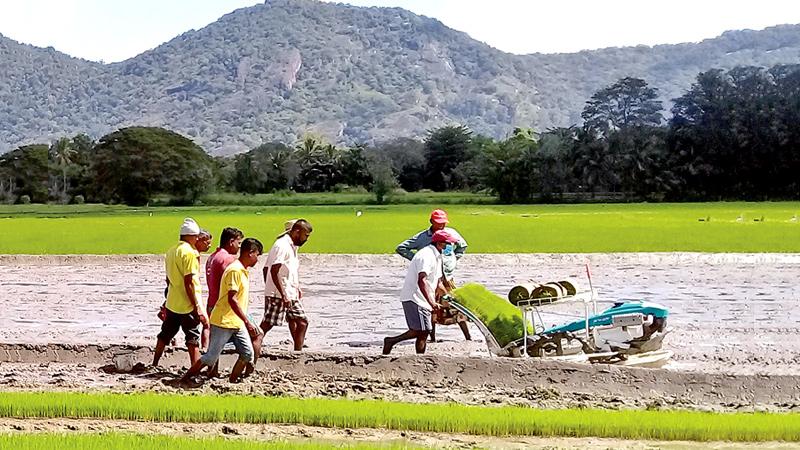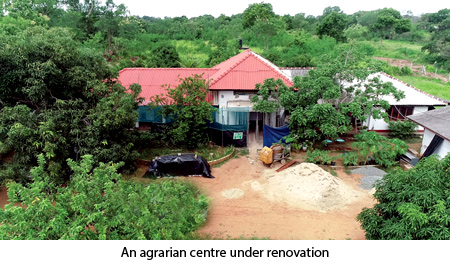
Dry zone of Sri Lanka being the most agriculturally productive region of Sri Lanka bears a long history of irrigation water management for agricultural production. The expansion of crop cultivation in the North, East and Southeast dry zones of the country was enabled through the construction of elaborate water management systems dating back to the period between 500 BC and 300 AD. The systems are based on water captured in small reservoirs known as minor irrigation tanks connected through canals forming cascades.
 However, with the expansion of large scale water storage and irrigation infrastructure, these small tanks system in the dry zone of Sri Lanka was paid less attention. The World Bank Funded Climate Smart Irrigated Agriculture Project (CSIAP) is being implemented to uplift the agriculture livelihood of small-scale tank based farming community in the most climatically vulnerable farming areas of the country. The project development objective is to improve the productivity and climate resilience of smallholder agriculture sector in selected hotspot areas. The project is implemented over six years ending in 2024.
However, with the expansion of large scale water storage and irrigation infrastructure, these small tanks system in the dry zone of Sri Lanka was paid less attention. The World Bank Funded Climate Smart Irrigated Agriculture Project (CSIAP) is being implemented to uplift the agriculture livelihood of small-scale tank based farming community in the most climatically vulnerable farming areas of the country. The project development objective is to improve the productivity and climate resilience of smallholder agriculture sector in selected hotspot areas. The project is implemented over six years ending in 2024.
Mega climate smart irrigated agriculture projects have been launched during the past few years, such as the Climate Resilient Integrated Water Management Project (CRIWMP) and Integrated Watershed and Water Reservoirs Management Project.
World Bank funded project
The World Bank Funded Climate Smart Irrigated Agriculture Project is designed to support farmers who are vulnerable to climate change and especially to climate-induced extreme events such as drought and flood in identified prone areas in 11 districts namely Anuradhapura, Polonnaruwa, Kurunegala, Puttalam, Kilinochchi, Mulaitivu, Trincomalee, Baticatoa, Ampara, Moneragala and Hambanthta, 18 sub watersheds of 10 river basins of Modaraam Aru, Yan Oya, Mee Oya, Kala Oya, Peru Aru, Mandakalaru, HadaOya, KarandaOya, KirindiOya and Menik river.
 According to Project Director Eng. R.M.B. Rajakaruna, the Climate Smart Irrigated Agriculture Project sponsored by the Ministry of Agriculture is a World Bank funded project at a cost of US $ 125 million. The CSIAP consists of four main components such as Agriculture production and marketing (US$ 31.3 m), Water for Agriculture (US$ 73.0m), Project management (US$ 5.7 m) and contingency Emergency Emerging Response (US$ 15.0m).
According to Project Director Eng. R.M.B. Rajakaruna, the Climate Smart Irrigated Agriculture Project sponsored by the Ministry of Agriculture is a World Bank funded project at a cost of US $ 125 million. The CSIAP consists of four main components such as Agriculture production and marketing (US$ 31.3 m), Water for Agriculture (US$ 73.0m), Project management (US$ 5.7 m) and contingency Emergency Emerging Response (US$ 15.0m).
Main programs
The main ongoing programs are agriculture production including Yala and Maha mid season cultivation, organic fertiliser production, cluster village development, climate smart nutritional home gardens, the farmer field school at Thirappane, rehabilitation of agriculture roads and agro wells, and minor tank rehabilitation. The agriculture program of the CSIAP has been launched on the sidelines of the government’s national food production drive in terms of the President’s Saubhagye Dekma. The food production program in the Yala season 2020 and 2021 was implemented in 11 hotspot areas despite the fact that country’s economy was affected by Covid-19 pandemic. This atmosphere strengthened the local food production while saving valuable foreign exchange spent for import of other food crops.
Some 7,500 metric tons of other field crops were produced with the involvement of 11,137 beneficiaries including 4,848 women farmers. Farmers came under this scheme have earned 1,097 million rupees. In the Maha season 2020 and 2021 covered 3,483 hectares in the 11 districts with 8,424 beneficiaries. The project expenditure was Rs. 48.56 million and farmers involved earned Rs. 1,081 million. Some 9,168 metric tons of food were produced during the period.
CSIAP home gardens were also introduced to beneficiary houses with the objective of saving minimum 10 percent of monthly expenses on food in the CSIAP project area producing chemical free fresh vegetables, fruits and yam varieties following climate smart agriculture practices. Some 2,695 home gardens out of 4,230 have been already established in the 11 districts.
Model village program
The estimated total cost of this is 84.88 million rupees. In support of this program, the climate smart model village program is being implemented on the basis of establishing one such model village in each agrarian service centre jurisdiction. The main objectives of this venture are to highlight the importance of climate smart agriculture in project and to improve crop productivity. It is reported that the Climate Smart Irrigated Agriculture Project has been moving forward in 11 districts spreading across northern, North Central, North Western, Eastern, Southern and Uva provinces.
The CMIAP’s Project Director Rajakaruna said that Sri Lanka is prone to climate changes. The agriculture in which nearly 25 percent of the labour force is employed is the most affected sector owing to climate changes. This program emphasises the rehabilitation of small tank cascades in Dry Zone aiming to conserve water for agriculture to face the frequent water shortages.
The World Bank provides a loan of US $ 110 million while the Government contributes US $ 10 million and community contribution is estimated at five million USD. Some 1,200 irrigation tanks will be rehabilitated to enable over 65,000 farmer families to cultivate 81,468 hectares of land. The project has begun to rehabilitate irrigation tanks, anicuts, canals and drainage systems of 121 cascades, Rajakaruna said.
The climate smart irrigated agriculture address the challenges of building synergies among climate change mitigation, adaption and food crops production, minimising their potential negative trade-offs.
As such the urgency for climate resilient economic development remains important in the fields of achieving equitable, efficient outcomes in the national agricultural efforts. Also the ongoing project is implemented in hotspot areas in the earmarked 11 districts that are being most affected by the recurrent monsoon failures of recent years.
These areas account for a population of 470,000 people and the project area of around 375,000 hectares covered in 22 sub watersheds in 15 river basings. The CSIAP is aiming to improve the climate resilience of farming in hotspot areas while augmenting the water supply for agriculture activities. Smallholder farmers consist of small scale farmers cultivating one to two hectares.
They will gain knowledge through technology transfer and access to infrastructure assests to enhance climate resilience in farming resulting in increased revenue from crop diversification and participation in emerging value chains. The project intends to promote the participation of youth and women communities in all key project interventions to ensure that they would benefit from the project activities as a whole.
Modernisation
Under the Climate Smart Irrigated Agriculture Project among the range of interventions, special attention is drawn to the modernisation of Agrarian Services centres.
The overall objective of modernising 47 Agrarian Service Centres in the 11 districts is to develop these grass-roots level farmers’ centres as one stop service centres to provide an efficient service to the farmer community. The total civil cost of this is Rs 337.40 million. In addition farm mechanisation is promoted to reduce cost of production and increase the productivity.
Fully equipped farmer machinery units will be established in 47 agrarian service centres increasing farmer access to machineries. The estimated cost of the two pilot units as an initiative is Rs. 239 million. In 2022, the Treasury has allocated Rs 2,500 million for development to cover six provinces and 11 districts.
Implementation of 33 cluster village development program, Yala, Maha and mid season cultivation and establishment of 39 demonstration plots to make aware the farmers for climate smart practices and conducting exposure visits to dissemination of knowledge are among them. It is envisaged to cover 6,000 hectares providing water saving techniques during this year.
In 2022 to support the government efforts to promote organic fertilising program under the CSIAP a compost production program has been started hoping to manufacture 50,000 mt of solid compost. CSIAP has developed Hotspot Agricultural Development Plan (HSAAPD) which addresses the grassroots level interventions in terms of uplifting the agriculture livelihood of the farming communities. The HSAAPD was prepared with the participation of all stakeholders.
It is implemented at Grama Niladhari, Divisional and district levels. The director planning of the District Secretariats handles these processes in collaboration with the Deputy Director Office of the CSIAP.
The main objective of the project is to improve the climate resilience of farming communities and the productivity of irrigated agriculture in selected climatically vulnerable areas in eleven districts in the six provinces.
